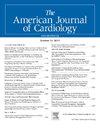Association of Mechanical Circulatory Support and Cardiac Catheterization Laboratory Procedural Volumes With Outcomes of Cardiogenic Shock
IF 2.3
3区 医学
Q2 CARDIAC & CARDIOVASCULAR SYSTEMS
引用次数: 0
Abstract
Despite advancements in cardiogenic shock (CS) management, mortality remains high. While hospital volume has been linked to reduced mortality across myriad complex procedures, the cross-volume effects of mechanical circulatory support (MCS) and cardiac catheterization laboratory (CCL) procedures on CS patients not receiving these interventions remain unexplored. Using the 2016 to 2022 Nationwide Readmissions Database, we analyzed nonelective adult CS admissions at MCS- and CCL-capable hospitals. Hospitals were stratified into quartiles by annual volumes of MCS (intra-aortic balloon pump, percutaneous ventricular assist device, extracorporeal membrane oxygenation) and CCL procedures (coronary angiography, percutaneous coronary intervention), with the top quartile classified as high-volume (HVH-MCS or HVH![]() CCL). Multivariable logistic and linear regression models were constructed to evaluate the independent association of high-volume status with mortality, complications, and resource utilization. Among 130,822 CS hospitalizations, 48.2% were treated at HVH-MCS and 46.1% at HVH
CCL). Multivariable logistic and linear regression models were constructed to evaluate the independent association of high-volume status with mortality, complications, and resource utilization. Among 130,822 CS hospitalizations, 48.2% were treated at HVH-MCS and 46.1% at HVH![]() CCL. Unadjusted mortality was lower at HVH-MCS (24.8% vs 30.7%, p <0.001) and HVH
CCL. Unadjusted mortality was lower at HVH-MCS (24.8% vs 30.7%, p <0.001) and HVH![]() CCL (26.6% vs 29.0%, p <0.001). Following adjustment, HVH-MCS remained associated with reduced mortality (Adjusted odds ratio [AOR] 0.87, 95% confidence interval [CI] 0.82 to 0.93), while HVH
CCL (26.6% vs 29.0%, p <0.001). Following adjustment, HVH-MCS remained associated with reduced mortality (Adjusted odds ratio [AOR] 0.87, 95% confidence interval [CI] 0.82 to 0.93), while HVH![]() CCL showed no significant benefit (p = 0.10). HVH-MCS also had lower respiratory (AOR 0.82, 95% CI 0.78 to 0.86) and infectious (AOR 0.85, 95% CI 0.80 to 0.90) complications, but longer hospital stays (β +1.75 days, 95% CI 1.48 to 2.01) and higher costs (+$8,600, 95% CI 7,100 to 10,100). Increasing MCS volume appears independently correlated with improved CS outcomes, highlighting the cross-volume effect of institutional expertise. Contrastingly, CCL volume was not associated with in-hospital mortality, supporting centralization of CS care at high-volume MCS centers.
CCL showed no significant benefit (p = 0.10). HVH-MCS also had lower respiratory (AOR 0.82, 95% CI 0.78 to 0.86) and infectious (AOR 0.85, 95% CI 0.80 to 0.90) complications, but longer hospital stays (β +1.75 days, 95% CI 1.48 to 2.01) and higher costs (+$8,600, 95% CI 7,100 to 10,100). Increasing MCS volume appears independently correlated with improved CS outcomes, highlighting the cross-volume effect of institutional expertise. Contrastingly, CCL volume was not associated with in-hospital mortality, supporting centralization of CS care at high-volume MCS centers.
机械循环支持和心导管实验室操作容积与心源性休克结局的关系。
尽管在心源性休克(CS)管理方面取得了进展,但死亡率仍然很高。虽然医院容量与无数复杂手术的死亡率降低有关,但机械循环支持(MCS)和心导管实验室(CCL)手术对未接受这些干预措施的CS患者的跨容量影响仍未探索。使用2016-2022年全国再入院数据库,我们分析了MCS和ccl能力医院的非选择性成人CS入院情况。根据MCS(主动脉内球囊泵、经皮心室辅助装置、体外膜氧合)和CCL(冠状动脉造影、经皮冠状动脉介入治疗)的年量将医院分为四分位数,最高的四分位数被分类为高容量(HVH-MCS或HVH-CCL)。构建多变量logistic和线性回归模型来评估高容量状态与死亡率、并发症和资源利用的独立关联。在130,822例CS住院患者中,48.2%在HVH-MCS接受治疗,46.1%在HVH-CCL接受治疗。HVH-MCS的未调整死亡率较低(24.8% vs 30.7%, p
本文章由计算机程序翻译,如有差异,请以英文原文为准。
求助全文
约1分钟内获得全文
求助全文
来源期刊

American Journal of Cardiology
医学-心血管系统
CiteScore
4.00
自引率
3.60%
发文量
698
审稿时长
33 days
期刊介绍:
Published 24 times a year, The American Journal of Cardiology® is an independent journal designed for cardiovascular disease specialists and internists with a subspecialty in cardiology throughout the world. AJC is an independent, scientific, peer-reviewed journal of original articles that focus on the practical, clinical approach to the diagnosis and treatment of cardiovascular disease. AJC has one of the fastest acceptance to publication times in Cardiology. Features report on systemic hypertension, methodology, drugs, pacing, arrhythmia, preventive cardiology, congestive heart failure, valvular heart disease, congenital heart disease, and cardiomyopathy. Also included are editorials, readers'' comments, and symposia.
 求助内容:
求助内容: 应助结果提醒方式:
应助结果提醒方式:


